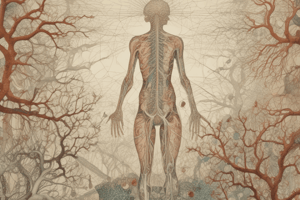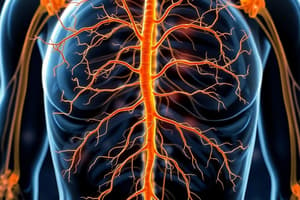Podcast
Questions and Answers
Neurons are classified as what type?
Neurons are classified as what type?
- Tripolar
- Multipolar (correct)
- Unipolar
- Bipolar
What do neurons consist of?
What do neurons consist of?
Axons
What supports neurons?
What supports neurons?
Neurological cells
What insulates neurons?
What insulates neurons?
What type of function is autonomic?
What type of function is autonomic?
What does the nervous system function in?
What does the nervous system function in?
Motor functions are divided into what?
Motor functions are divided into what?
What is the nervous system divided into?
What is the nervous system divided into?
The brain is made of what part?
The brain is made of what part?
Midbrain is made of what?
Midbrain is made of what?
The brain is made of what part?
The brain is made of what part?
Midbrain functions in what?
Midbrain functions in what?
Cerebrum functions in what?
Cerebrum functions in what?
The cerebrum is made of what part?
The cerebrum is made of what part?
The cerebrum is made of what part?
The cerebrum is made of what part?
The central nervous system consists of what?
The central nervous system consists of what?
What do neurons require?
What do neurons require?
Flashcards
Multipolar Neurons
Multipolar Neurons
Neurons with multiple branches extending from the cell body, allowing for the integration of signals from various sources.
Axons
Axons
Long, slender projections of neurons responsible for transmitting electrical impulses away from the cell body.
Neurological Cells
Neurological Cells
Specialized cells that support and protect neurons, providing structural and functional support to neural tissue.
Myelin
Myelin
Signup and view all the flashcards
Autonomic Nervous System
Autonomic Nervous System
Signup and view all the flashcards
Sensory Processing
Sensory Processing
Signup and view all the flashcards
Somatic Nervous System
Somatic Nervous System
Signup and view all the flashcards
Central Nervous System (CNS)
Central Nervous System (CNS)
Signup and view all the flashcards
Spinal Cord
Spinal Cord
Signup and view all the flashcards
Midbrain
Midbrain
Signup and view all the flashcards
Brainstem
Brainstem
Signup and view all the flashcards
Cerebellum
Cerebellum
Signup and view all the flashcards
Cerebrum
Cerebrum
Signup and view all the flashcards
Occipital Lobe
Occipital Lobe
Signup and view all the flashcards
Parietal Lobe
Parietal Lobe
Signup and view all the flashcards
Neurotransmitters
Neurotransmitters
Signup and view all the flashcards
Study Notes
Nervous System Overview
- Neurons are classified as multipolar, which allows for the integration of multiple inputs.
- Neurons consist of axons, which are responsible for transmitting electrical impulses away from the cell body.
Support and Insulation
- Neurons are supported by neurological cells, which provide structural and functional support to the neural tissue.
- Neurons are insulated by myelin, a fatty substance that enhances signal transmission speed along axons.
Autonomic Functions
- The autonomic nervous system is characterized by its involuntary functions, regulating activities such as heart rate and digestion.
Functions of the Nervous System
- The nervous system functions in sensory processing, gathering information from the environment to respond appropriately.
- Motor functions are divided into somatic and autonomic components, with somatic nervous system controlling voluntary movements.
Divisions of the Nervous System
- The nervous system is divided into the peripheral nervous system (PNS) and the central nervous system (CNS).
- The central nervous system consists of the spinal cord, which serves as a major pathway for information between the brain and the body.
Brain Structure
- The brain is made up of various parts, including the midbrain, which is involved in regulating several bodily functions.
- The midbrain is part of the brainstem, responsible for basic life functions such as breathing and heart rate.
- The brain also includes the cerebellum, which is crucial for coordination and balance.
Cerebrum Functions and Components
- The cerebrum is responsible for higher functions such as memory, decision making, and sensory perception.
- The cerebrum is comprised of different lobes, including the occipital lobe, which processes visual information, and the parietal lobe, which integrates sensory information from various modalities.
Neurotransmitter Requirements
- Neurons require neurotransmitters for communication between cells, facilitating the transmission of signals across synapses.
Studying That Suits You
Use AI to generate personalized quizzes and flashcards to suit your learning preferences.




